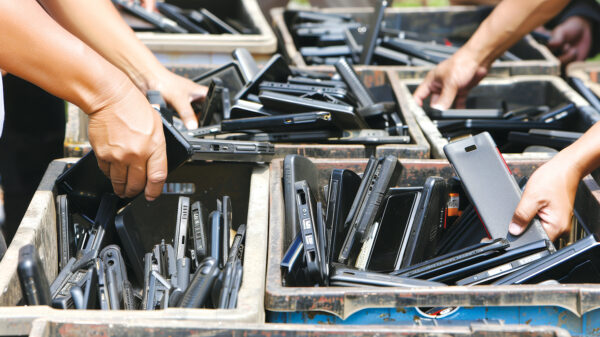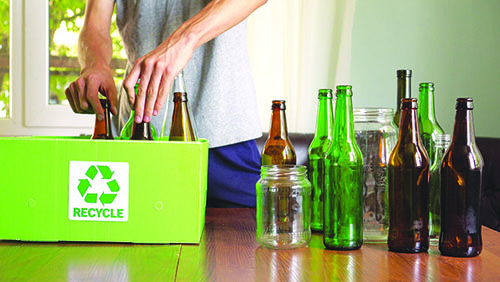by MAURA KELLER
According to the U.S. Energy Information Administration (EIA), for every 100 pounds of municipal solid waste (MSW) in the U.S., about 85 pounds can be burned as fuel to generate electricity.

This waste-to-energy (WTE) process is gaining momentum as the impact of WTE plants means that 2,000 pounds of MSW can be reduced to 300 to 600 pounds of ash, reducing the volume of waste by 87 percent.
WTE plants account for a relatively small portion of U.S. electric generating capacity (mainly concentrated in the Northeast and in Florida), primarily due to the significant upfront capital costs of building WTE combustion plants. As a result, in August 2022, the EIA released an update to the U.S. waste-to-energy electric generating capacity indicating that for the first time in 24 years, the capacity has started to decline. This is primarily due to lower electricity prices, policy concerns about WTE plant emissions and local opposition.
Brent Trenga, director of sustainability for Kingspan Panels North America has been at the helm of waste-to-energy programs, as well as programs to divert waste-to-landfill for all of Kingspan’s North America manufacturing sites.
“We are seeing the effects of climate change daily – more major hurricanes, brutal wildfires and severe flooding. As the problem gets harder to ignore, more companies are looking inward to see how they can reduce their impact on the planet,” Trenga said. “Companies will realize that waste-to-energy can be the first step in reducing the volume of material going to landfill.”
Kingspan has embraced the waste-to-energy movement through the company’s global Planet Passionate sustainability program, a multi-faceted strategy for reducing the company’s environment input.
“Part of the program is to divert 100 percent of its waste from landfills by 2030. At our plant, mineral fiber waste accounts for nearly half the waste generated. It is now sent back to the supplier to make new products,” Trenga said. The remaining waste from this facility has a short-term waste-to-energy program in place to ensure it does not end up in a landfill, and instead, creates an energy source that is cleaner than fossil fuels.
“This fills the gap until we can find alternative recycling streams for each of the materials collected,” Trenga said.
Kim Bredahl, senior vice president at Babcock & Wilcox Renewable, pointed out that globally, there is considerable discussion of the circular economy and the role recycling and energy production play. Babcock & Wilcox is supporting efforts to help create a sustainable, circular economy utilizing the company’s advanced waste-to-energy technologies to produce clean, low-emissions energy and support recycling.
“Waste-to-energy creates a beneficial use for waste that can’t be recycled or that has reached the end of its recyclability,” Bredahl said. “Our technologies, which uses waste as fuel to produce steam for power generation, heating and industrial processes, help divert waste from landfills and reduce net greenhouse gas emissions by eliminating the source of landfill methane, a potent greenhouse gas which is created when organic waste breaks down in a landfill.”
The Kingspan WTE program is an example of a program that boasts extremely aggressive targets.
“Construction and demolition debris accounts for more than twice the municipal waste generated, according to the EPA,” Trenga said. “As a building products manufacturer, we must find ways to reduce that material. Mineral fiber insulation is difficult to upcycle or recycle, which is why we need to work with the original supplier directly.”
Kingspan is also seeking local partners at each of its five manufacturing sites who can incorporate the company’s foam scrap into new products. Kingspan’s global innovation team is actively working on chemically recycling the foam, so they are able to reclaim valuable raw materials back into their process.
“We are committed to finding ways to divert 100 percent of waste from landfills by 2030. The waste-to-energy program is a short term solution that allows our waste to stay out of landfills,” Trenga said.
Bredahl added that one of the biggest drivers of demand for waste-to-energy, as well as the need for recycling, is population growth. Population growth, coupled with increasing urbanization and the increasing affluence of people worldwide, results in more waste being produced.
“Governmental policies and legislation that focus on protecting the environment – particularly in Europe, parts of Asia and some regions in the U.S. – are incentivizing the use of waste-to-energy as a solution for waste and an alternative to landfills,” Bredahl said.
As the Kingspan WTE program illustrates, there are environmental and economic benefits to waste-to-energy. The environmental benefits include decreased reliance on landfills and a reduction in pollution (such as runoff) caused by landfills, as well as the elimination of landfill methane emissions.
“Methane emissions, according to the U.S. Department of Energy, is a greenhouse gas with 80 times the global warming potential (GWP) of carbon dioxide over a 20 year period,” Bredahl said. “Economically speaking, in some parts of the world where landfill space is limited, it is very expensive to bury waste. Waste-to-energy saves money by greatly reducing reliance on landfills and producing beneficial clean energy for the community.”
Embracing Challenges
Bredahl said one of the biggest challenges facing the WTE efforts is overcoming the misperceptions that abound about waste-to-energy. Of course, part of these misperceptions on the part of the general public, is a lack of understanding about what WTE is and how it can improve communities. In fact, in communities where waste-to-energy is coupled with recycling programs, the team at Babcock & Wilcox Renewable often see increased participation in recycling. Waste-to-energy also is clean, renewable energy.
“We’re turning unrecyclable waste that would otherwise end up in a landfill into baseload power and we’re able to control emissions through advanced environmental technologies. Waste-to-energy can even be paired with carbon capture technologies to produce energy with net-negative greenhouse gas emissions,” Bredahl said.
Modern waste-to-energy facilities are also highly compatible with municipal areas and can become important parts of and contributors to the communities they serve, providing needed power, economic growth, jobs and even recreational opportunities. Bredahl pointed to two examples featuring Babcock & Wilcox’s steam generation and environmental technologies. These include the Palm Beach Renewable Energy Center, which includes a nature conservation area and recreational trails, and is located in the community of West Palm Beach, Florida, and the Copenhill/Amager Bakke waste-to-energy facility near Copenhagen, Denmark, which includes a public park, year-round ski slope and even a café on the power plant itself.
“Both facilities play important roles in the communities they serve, and their benefits have been embraced by residents. The Copenhill/Amager Bakke facility has even become a tourist attraction,” Bredahl said. “Embracing waste-to-energy is an important part of building a circular economy, creating sustainable renewable energy and supporting recycling programs. At the same time, it is a solution for eliminating landfill methane emissions and combatting climate change. We hope that governments and communities around the world will take a close look at waste-to-energy as a source of clean, renewable energy.”
Published in the November 2022 Edition







